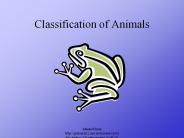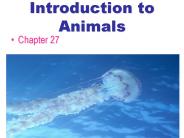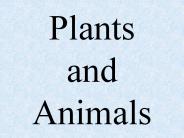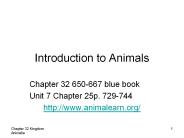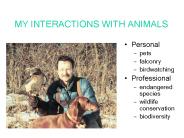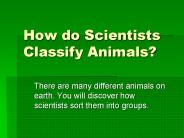Animals With Backbone PowerPoint PPT Presentations
All Time
Recommended
Title: Animal Survival Author: Betty Alspaugh Last modified by: Richard Hughes Created Date: 10/16/2006 11:39:10 PM Document presentation format: On-screen Show (4:3)
| PowerPoint PPT presentation | free to download
adaptation in animals the idea that certain animals have developed features which help them survive in their environment Elephants Elephant's bodies are well ...
| PowerPoint PPT presentation | free to download
Arthropods are different from all other animals because they are eucoelomates with a hard, segmented body. The phylum Arthropoda (jointed-foot) consists of most of ...
| PowerPoint PPT presentation | free to download
Kinds of animals with backbone. Mammal, Bird, Fish, Amphibians, and Reptiles are examples of Vertebrates Animals. Science for Primary
| PowerPoint PPT presentation | free to download
Porifera & Cnidarians - chs.helenaschools.org ... Animals
| PowerPoint PPT presentation | free to view
Animals Created by: Leah Beard, LMES 1. What do all animals need? A: wings B: food C: fins D: rocks 2. A dolphin is a _____. A. fish B. mammal C. whale D. reptile 3.
| PowerPoint PPT presentation | free to download
Animals Need . Food Water Air Shelter Animals Need . Food Water Air Shelter Animal Groups Mammals Birds Reptiles Fish Amphibians Mammals Hair or fur Backbone ...
| PowerPoint PPT presentation | free to view
... fish with bony skeletons most fish Class Amphibia: amphibians salamanders, frogs have smooth skin require water to lay eggs Class Reptilia: ...
| PowerPoint PPT presentation | free to view
Heterotrophs - Cannot make their own food, must get energy by eating plants or other ... Endothermic animals must eat much more often than an ectodermic animal. ...
| PowerPoint PPT presentation | free to view
Classification of Animals Animals With Backbones Animals with backbones are called vertebrates. Vertebrates include many different kinds of animals.
| PowerPoint PPT presentation | free to download
Mammals Vertebrates Animals with a backbone Includes: fish, amphibians, reptiles, birds, and mammals (listed in order of complexity) ...
| PowerPoint PPT presentation | free to view
Complex Animals
- Complex Animals Animals are spilt into two major groups: Vertebrates Invertebrates
Complex Animals Animals are spilt into two major groups: Vertebrates Invertebrates
| PowerPoint PPT presentation | free to view
Kingdom Animalia Animals are: Multicellular, with tissues and organ systems that perform specialized functions Eukaryotic, with no cell walls Heterotrophic
| PowerPoint PPT presentation | free to view
II) Fish. A) Agnatha: jawless fish. 1) suction mouth. 2) notochord remains. a)lack bony skeleton cartilage. 3) ex. lamprey and hagfish *
| PowerPoint PPT presentation | free to download
Vertebrate Animals Highlight what is BOLD/UNDERLINED DOMAIN- Eukarya KINGDOM- Animalia PHYLUM- Chordata SUBPHYLUM- Vertebrata CLASS- 7 different ORDERS- 10 Placental ...
| PowerPoint PPT presentation | free to download
CHAPTER NEW CHAPTER Invertebrate Animals the BIG idea Invertebrate animals have a variety of body plans and adaptations. 4.1 Most animals are invertebrates.
| PowerPoint PPT presentation | free to view
Invertebrates are animals that have a spine, also called a backbone. ... This gorilla and other primates and mammals, such as humans, are all vertebrates. ...
| PowerPoint PPT presentation | free to view
Chapter #7 Simple Animals Chapter 7.1 Notes Traits of Animals Animals can not make food Most animals can move from place to place. Animals have many cells.
| PowerPoint PPT presentation | free to view
Marine Animals Ex of amphibians: frogs, salamanders Require water to remove waste Salt water will cause them to dehydrate b/c water will flow out of instead of into ...
| PowerPoint PPT presentation | free to view
Vertebrate Animals Highlight what is BOLD/UNDERLINED DOMAIN- Eukarya KINGDOM- Animalia PHYLUM- Chordata SUBPHYLUM- Vertebrata CLASS- 7 different ORDERS- 10 Placental ...
| PowerPoint PPT presentation | free to download
Kingdom Animalia Characteristics of the Animal Kingdom Over 2 Million Species Eukaryotic Heterotrophic Multicellular No Cell Walls General Classification ...
| PowerPoint PPT presentation | free to view
Deuterostomate Animals
| PowerPoint PPT presentation | free to view
Introduction to animals Introduction to Animals
| PowerPoint PPT presentation | free to view
Animals: The Invertebrates Chapter 23
| PowerPoint PPT presentation | free to view
Carnivores: animals that eat other animals ... Detritivores: feed on decaying animal and plant material called detritus. Symbiotic relationship: ...
| PowerPoint PPT presentation | free to view
Introduction to Animals Chapter 27
| PowerPoint PPT presentation | free to download
In the reading, Classifying Animals, we ll look at how and why animals are classified into . ... Some lay eggs in water. Department of Mathematics and Science.
| PowerPoint PPT presentation | free to view
GUINEA PIGS HAMSTERS. INSECTS LIZARDS. MICE RABBITS. RATS REPTILES. EXOTICS LARGE ANIMALS ... More than 5300 species of passerines, alone. Early Ancestors of Birds ...
| PowerPoint PPT presentation | free to view
The Kingdom ANIMALS Eukaryotic cells Multicellular Heterotrophic by ingestion External Fertilization vs Internal Fertilization a. Invertebrate Chordates: Tunicates ...
| PowerPoint PPT presentation | free to view
Introduction to Animals Essential Questions: What makes an animal an animal? How are animals classified? Kingdom Animalia Eukaryotic Heterotrophic Multicellular ...
| PowerPoint PPT presentation | free to view
Vertebrates have a skull and backbone to protect most of the nervous system. ... b. Warning coloration-bright designs. c. Threatening appearance-horns, toxins ...
| PowerPoint PPT presentation | free to view
INTRODUCTION TO ANIMALS Chapter 34 Animal Basics 4 Defining Characteristics Morphology (animal bodies) Invertebrates versus vertebrates Morphology Symmetry Radial ...
| PowerPoint PPT presentation | free to download
Plants and Animals Questions E. How are plants and animals similar and different? U1. What do we know about plants? A. What is a plant? B.
| PowerPoint PPT presentation | free to download
Title: INVERTEBRATES Author: SDHC Last modified by: Elizabeth Burton Created Date: 6/18/2004 2:19:09 PM Document presentation format: On-screen Show
| PowerPoint PPT presentation | free to download
Life Science - Animals Unit A Chapter 2, Lessons 1-3 Chapter 4 Lesson 2 by Brooke M. McFry 2:1 How are animals grouped? trait a feature passed on to a living ...
| PowerPoint PPT presentation | free to download
Introduction to Animals Chapter 32 650-667 blue book Unit 7 Chapter 25p. 729-744 http://www.animalearn.org/ Chapter 32 Kingdom Animalia ...
| PowerPoint PPT presentation | free to download
Animals: The Invertebrates
| PowerPoint PPT presentation | free to view
adaptation in animals the idea that certain animals have developed features which help them survive in their environment Elephants Elephant's bodies ...
| PowerPoint PPT presentation | free to download
Animals are grouped into about 35 phyla (mostly aquatic). Vertebrates make up one subphylum within the Phylum Chordata less than 5 ... Sea Anemone, Cnidarians) ...
| PowerPoint PPT presentation | free to view
The Kingdom Animalia The movers and shakers Part I: Introduction to animals and the phyla Porifera and Cnidaria. Gulo gulo * * * What are animals?
| PowerPoint PPT presentation | free to download
Animals, Part I Invertebrates Introduction to Animals (Chapter 34) Sponges and Jellyfish (Chapter 35) Simple Worms (Chapter 36) Mollusks and Annelids (Chapter 37)
| PowerPoint PPT presentation | free to view
Chapter 30: Animals: Part I Evolution and Classification of Animals Animals are multicellular heterotrophs that ingest their food. Animals belong to the Eukarya and ...
| PowerPoint PPT presentation | free to view
... and a few species of frogs and lizards Parthenogenesis in the Komodo Dragon Mating and Mating Behaviors Beetles Mating Male Female Young Courtship Levels of ...
| PowerPoint PPT presentation | free to view
Classifying Classy Animals
| PowerPoint PPT presentation | free to view
Intro to Life and Animals
| PowerPoint PPT presentation | free to download
Jellyfish - Anemones. II. Animal Diversity. B. Radiata Cnidarians. 1. Diversity - Hydras ... Jellyfish - Anemones - Corals. II. Animal Diversity. a. ...
| PowerPoint PPT presentation | free to view
Introduction to Animals What is an Animal? Members of Kingdom Animalia Multicellular Eukaryotic Heterotrophic Cells have no cell wall All animals in 2 categories ...
| PowerPoint PPT presentation | free to view
This PowerPoint presentation was developed to coincide with an eighth grade science textbook. This PowerPoint presentation is used to introduce and teach vocabulary ...
| PowerPoint PPT presentation | free to view
Title: HUMAN-WILDLIFE RELATIONSHIPS Author: Stanley Temple Last modified by: jreich Created Date: 4/8/2003 7:16:07 PM Document presentation format
| PowerPoint PPT presentation | free to download
Have a vertebral column, or backbone; this is made of ... spiny anteater and duckbilled platypus) Marsupials pouched mammals (ex. kangaroo and opossum) ...
| PowerPoint PPT presentation | free to view
Animals and Animal Diversity The Nitty-gritty! Note: There is no red on this powerpoint, all non-essentials were deleted from the notes. Just imagine that everything ...
| PowerPoint PPT presentation | free to view
How do Scientists Classify Animals? There are many different animals on earth. You will discover how scientists sort them into groups. Two big groups
| PowerPoint PPT presentation | free to download
All animals are Heterotrophs: Get their energy by eating other organisms. ... Zebras and Musk Oxen. Predator Adaptations. Speed and Camouflage ...
| PowerPoint PPT presentation | free to view
Unit 5 / Module 14 D. Communication involves the passing of information from one organism to another. 1. Innate forms of communication may involve sound (a whale s ...
| PowerPoint PPT presentation | free to view
Unit 5 / Module 14 D. Communication involves the passing of information from one organism to another. 1. Innate forms of communication may involve sound (a whale s ...
| PowerPoint PPT presentation | free to view
Phylum Chordata (the Chordates) includes both invertebrates and vertebrates that ... Monotremes (Example: duck-billed platypus) Egg-laying mammals ...
| PowerPoint PPT presentation | free to view










